The world’s most celebrated wine regions offer a diverse array of landscapes, climates and winemaking traditions that have shaped their reputations over centuries. From the iconic rolling hills of Tuscany and the sun-drenched vineyards of Napa Valley, to the historic wine estates of Stellenbosch and the steep terraced slopes of the Douro Valley, each destination boasts unique terroirs that produce distinctive wines enjoyed globally.
Wine tourism has become a key part of the experience, inviting visitors to explore not only the wines themselves, but also immerse themselves the rich culture, history and stunning vistas that define each region. In this article, we’ll take a closer look at some of the premier wine regions across the globe, from Europe to Africa, Oceania, and the U.S. and South America, highlighting what makes each destination a must-visit for oenophiles.
Monticello, Virginia
The Monticello Wine Region, centered around Charlottesville, is Virginia's most prominent wine-producing area and is known for its historical significance tied to Thomas Jefferson. Jefferson's vision for fine wine in the state laid the foundation for this thriving region, which boasts a diverse terroir shaped by the Blue Ridge Mountains. The Monticello Wine Trail, named after Jefferson’s estate, links more than 30 wineries, offering national and international award-winning wines, including Viognier, Cabernet Franc and Merlot.
With its combination of rich history, scenic landscapes and a vibrant winemaking culture, the Monticello region is a must-visit destination for wine enthusiasts. Situated at the heart of the Monticello AVA (American Viticultural Area) and therefore Virginia’s wine industry, the charming city of Charlottesville adds its own appeal, offering cultural experiences alongside world-class wines.
While other Virginia wine regions like the Shenandoah Valley and Middleburg are also important and growing, Monticello's historical significance, established AVA status, and concentration of quality wineries make it the most prominent wine country location in the Old Dominion state.
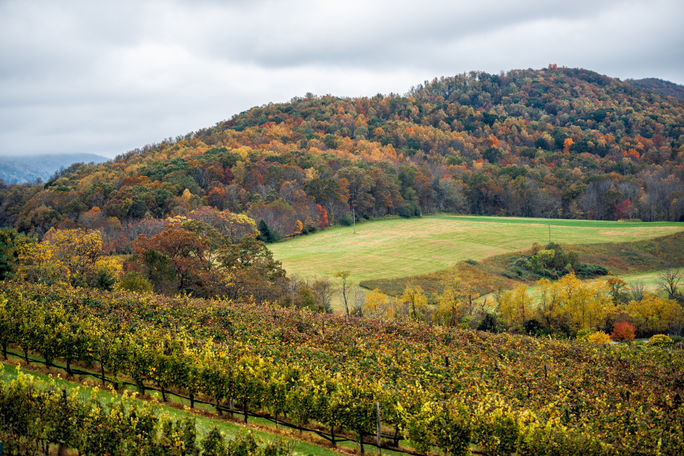
Vineyard in the Monticello AVA region of Virginia in autumn. (Photo Credit: Adobe Stock/Kristina Blokhin)
Napa Valley, California
Nestled in the agricultural reaches of Northern California, Napa Valley's prominence as the West Coast's premier wine region comes down to a unique combination of factors. Industry pioneers established a foundation for commercial wineries in the area by the mid-19th century, while ideal growing conditions—including warm days, cool nights and diverse soils—provided the perfect terroir for quality grape cultivation. A relentless focus on quality, bolstered by research and advanced techniques, has consistently placed Napa wines among the world's best. The pivotal "Judgment of Paris" in 1976, where Napa wines triumphed over their French counterparts, catapulted the region onto the international stage, solidifying its reputation for excellence.
Beyond terroir and talent, Napa Valley has cultivated a strong brand identity, effectively marketing itself as a luxury destination synonymous with American wine. This branding, coupled with a concentration of world-class winemaking professionals, has further solidified Napa's position among global winemaking regions. Now the most famous wine region in the U.S., this Northern California territory is particularly known for its world-class Cabernet Sauvignon, Michelin-starred restaurants and luxury resorts.
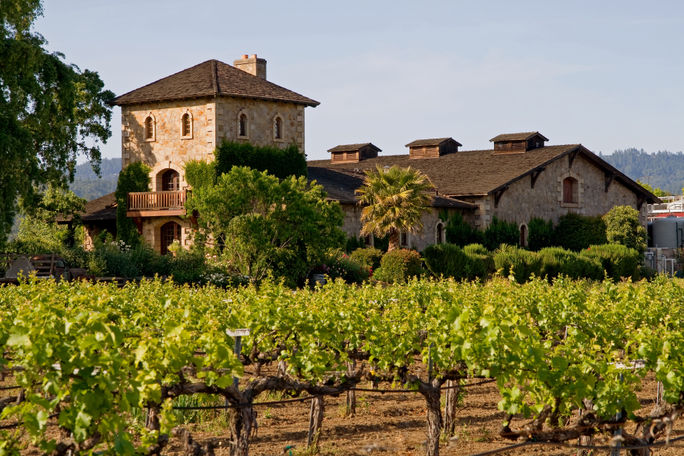
Winery in Napa Valley, California. (Photo Credit: Adobe Stock/Andy)
Barossa Valley, Australia
The Barossa Valley, located in South Australia, is one of the world’s most renowned wine regions, particularly famous for its bold, full-bodied Shiraz. With a winemaking history dating back to the 1840s, the valley was established by German settlers whose influence remains evident in the region’s culture and architecture. The area’s Mediterranean climate—with warm summers, temperate winters, mild nights and limited rainfall—creates ideal conditions for producing rich, complex reds, including Cabernet Sauvignon and Grenache. Some of Australia's most prestigious wineries, such as Penfolds, Henschke, and Torbreck, are based here, crafting wines that are celebrated globally.
Beyond its world-class wines, Barossa Valley is a premier destination for wine tourism, offering scenic vineyard landscapes, gourmet food experiences and historic charm. The region boasts around 150 wineries, ranging from small boutique producers to internationally recognized estates and 80 cellar doors. Visitors can enjoy immersive wine tastings, as well as wines paired with seasonal local dishes, and events like the Barossa Vintage Festival, which celebrates the area's rich viticultural heritage.
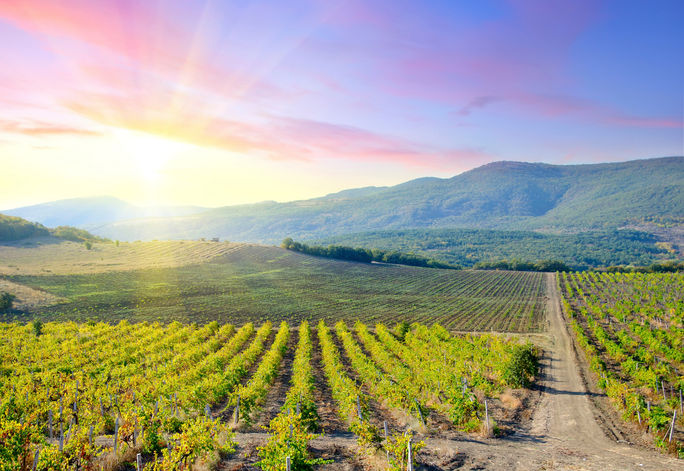
Daybreak at a vineyard in the Barossa Valley, Australia. (Photo Credit: Adobe Stock/tycoon101)
Marlborough, New Zealand
Marlborough, located on the northeastern tip of New Zealand’s South Island, is the country’s most famous and largest wine-producing region, best known for its crisp, aromatic Sauvignon Blanc. The region’s cool climate, long sunshine hours, and well-drained alluvial soils create the perfect conditions for producing intensely flavored, zesty wines with vibrant acidity. Marlborough’s Sauvignon Blanc, pioneered in the 1980s by wineries like Cloudy Bay, quickly gained international acclaim for its bold tropical fruit notes, citrusy freshness, and signature herbaceous character. In addition to Sauvignon Blanc, the region also produces excellent Pinot Noir, Chardonnay, and Riesling, showcasing its diverse terroir.
Beyond its world-class wines, Marlborough is a breathtaking wine destination, offering stunning vineyard landscapes, coastal beauty, and exceptional wine tourism experiences. Visitors can explore over 160 wineries and cellar doors, many offering immersive tastings and vineyard tours. The Marlborough Sounds, a picturesque network of waterways and islands, adds to the region’s charm, providing opportunities for boating, seafood dining, and scenic exploration. With its combination of award-winning wines, spectacular scenery, and warm Kiwi hospitality, Marlborough is an essential stop for wine lovers visiting New Zealand.
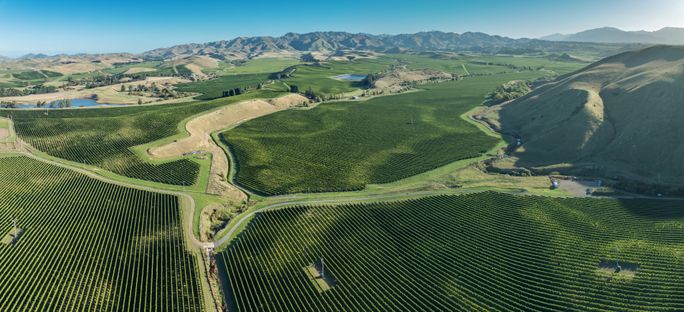
Aerial view of sprawling vineyards in Marlborough, New Zealand. (Photo Credit: Adobe Stock/Zenstratus)
Stellenbosch, South Africa
Stellenbosch, located in South Africa’s Western Cape, is the country’s most prestigious wine region and a cornerstone of its winemaking industry, home to nearly one-fifth of the nation’s vines. With a history dating back to the late 17th century, Stellenbosch has played a vital role in shaping South African viticulture, earning international acclaim for its wines. The region is particularly known for its bold red wines, especially Cabernet Sauvignon, Merlot, and Pinotage—South Africa’s signature grape. It also produces exceptional Chenin Blanc and Chardonnay, reflecting its diverse terroir and skilled winemaking.
Stellenbosch benefits from a Mediterranean climate, with warm, dry summers and cool, wet winters, as well as a variety of soil types, from decomposed granite to sandy loam. The nearby False Bay provides cooling maritime breezes, enhancing acidity and balance in the grapes.
Beyond its wines themselves, Stellenbosch is also a premier wine tourism destination, featuring historic Cape Dutch architecture, oak-lined streets and a vibrant university culture. The Stellenbosch Wine Route, one of South Africa’s oldest, includes over 150 wineries offering tastings, cellar tours and fine-dining experiences that highlight the region’s rich culinary traditions, making it a must-visit for wine lovers.
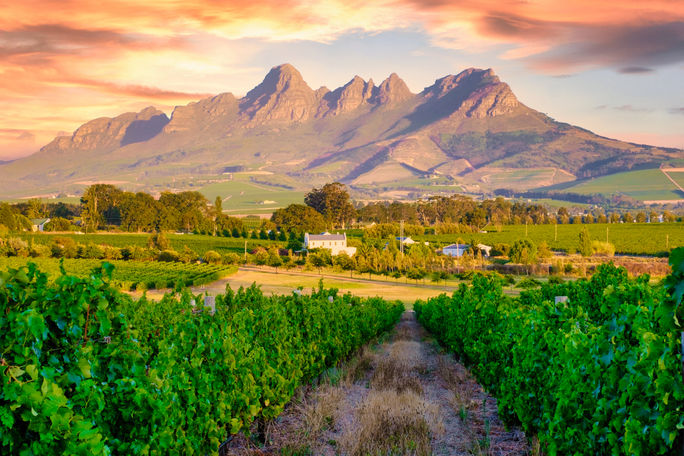
Vineyard landscape in Stellenbosch, South Africa. (Photo Credit: Adobe Stock/Chirapriya)
Burgundy, France
France’s famed Burgundy region stands as one of the most prestigious and revered wine regions in the world, celebrated for its exceptional Pinot Noir and Chardonnay. Its global reputation is built on centuries of winemaking tradition, an intricate terroir-driven classification system and a commitment to quality that has made its wines some of the world’s most sought-after. The region's vineyards, many of which are small, family-run plots, are meticulously maintained and their wines are classified in a special system, ranging from regional levels to the esteemed Grand Cru tier. Due to limited production and astounding global demand, Burgundy’s finest wines fetch astronomical prices at auctions and in the fine wine market.
Beyond its wines, Burgundy is an extraordinary destination for wine tourism, offering an authentic and intimate experience for oenophiles. The Route des Grands Crus, a scenic wine trail, takes visitors through some of the most iconic vineyards in the world, passing through charming medieval towns and historic cellars. Unlike larger, more commercialized wine regions, Burgundy's wineries are often small and family-owned, allowing for more personal, educational tastings with winemakers who have cultivated their craft for generations. Luxury hotels, boutique wine retreats and Michelin-starred restaurants elevate the experience available in this area, with many venues offering curated wine pairings and exclusive vineyard access.
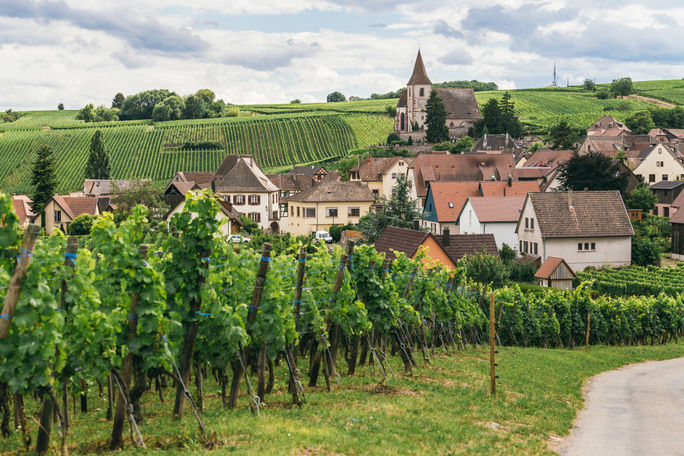
Grape fields in Burgundy, France. (Photo Credit: Adobe Stock/alexshyripa)
Mosel, Germany
While it might not be as large or as widely recognized as France or Italy, Germany has a long and respected winemaking tradition. With a unique terroir, the country’s Mosel region remains one of its most renowned wine-producing areas, famous for its steep vineyards along the winding Mosel River. Located in western Germany, the region stretches across parts of Rhineland-Palatinate, Luxembourg and France, with the majority of its vineyards situated in Germany. Mosel is known for its cool and often rainy climate, which provides ideal conditions for growing certain grapes—particularly Riesling, the region’s flagship grape variety. On the whole, Germany's wine regions are relatively small compared to other major wine-producing countries, but they are greatly esteemed for their high-quality products.
Wine tourism in Mosel is an experience that immerses visitors in the beauty of the landscape as much as it does in the region's winemaking heritage. The region boasts numerous small, family-owned wineries, some of which date back centuries, offering personalized wine tastings and tours. Many of these wineries are nestled in picturesque villages like Bernkastel-Kues, Traben-Trarbach and Cochem, where visitors can enjoy guided tours of the vineyards, learn about traditional winemaking methods, and sample a range of Mosel wines. In addition to tastings, many wineries offer wine-pairing experiences, showcasing local specialties alongside their wines. The narrow, steep vineyards are often accessible by hiking or cycling routes that offer breathtaking views of the river valley.

Bernkastel-Kues on the Mosel River, Germany. (Photo Credit: Adobe Stock/fotokunst63)
Tuscany, Italy
Located in central Italy, Tuscany is one of the world's most famous and celebrated wine regions, known for its rich winemaking history, picturesque landscapes and high-quality wines. The region’s wine culture dates back to the Etruscans and Romans, with Tuscan wines being integral to both its local culture and international recognition. The rolling hills of Tuscany, with their varied soils and microclimates, provide ideal conditions for growing a range of grape varieties. Tuscany is the birthplace of some of the most prestigious wine classifications in Italy, such as Chianti, Brunello di Montalcino and Vino Nobile di Montepulciano. These wines are known for their deep flavors, complexity, and ability to age, making them highly sought after by wine connoisseurs around the world.
Wine tourism in Tuscany is an immersive experience, blending the pleasures of tasting exceptional wines with the region’s stunning landscapes and historic charm. Visitors can tour renowned wine estates and vineyards, many of which are set in centuries-old castles or villas, offering an unparalleled sense of place. Tuscany’s wine regions, such as Chianti, Montalcino and Bolgheri, are dotted with wineries that welcome tourists for private tours and tastings. These tours often include a deep dive into the winemaking process, from vine to bottle, with many wineries showcasing traditional methods alongside innovative approaches. Guests can sample the region’s most iconic wines, which are often paired with local delicacies like pecorino cheese, olive oil and cured meats.
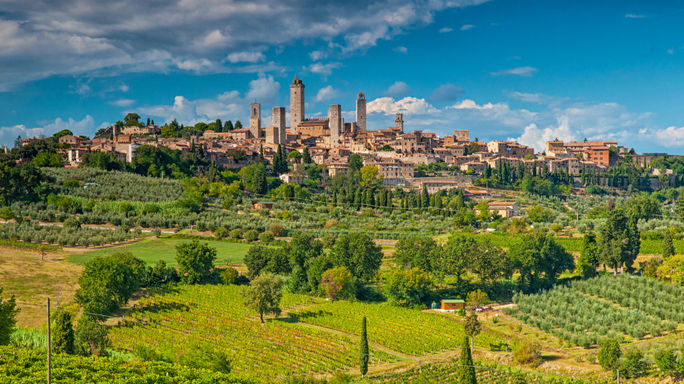
Medieval town of San Gimignano in Tuscany, Italy. (Photo Credit: Adobe Stock/Horváth Botond)
Rioja, Spain
Rioja, one of Spain’s most celebrated wine regions, is located primarily in the autonomous community of La Rioja in the north. With a winemaking history dating back to Roman times, the region blends deep-rooted tradition with modern innovation. Rioja is best known for its high-quality red wines, primarily crafted from Tempranillo, though Garnacha, Graciano, and Mazuelo also play key roles. The region’s diverse terroirs, ranging from Mediterranean-influenced lower valleys to the cooler higher elevations, provide a unique range of flavors in its wines.
Rioja viticulture also has a distinctive style, where wines are often categorized by their aging time in oak and bottle: Crianza, Reserva and Gran Reserva. The region is home to a mix of historic bodegas and cutting-edge wineries, offering immersive experiences like guided vineyard tours, tastings and wine-pairing opportunities with local delicacies such as pintxos, cured meats and artisanal cheeses. Visitors can also partake in lively wine festivals, including the Haro Wine Festival in June and the Rioja Wine Harvest Festival in September. With its exceptional wines, breathtaking landscapes, and vibrant wine culture, Rioja remains a top destination for wine enthusiasts from around the world.
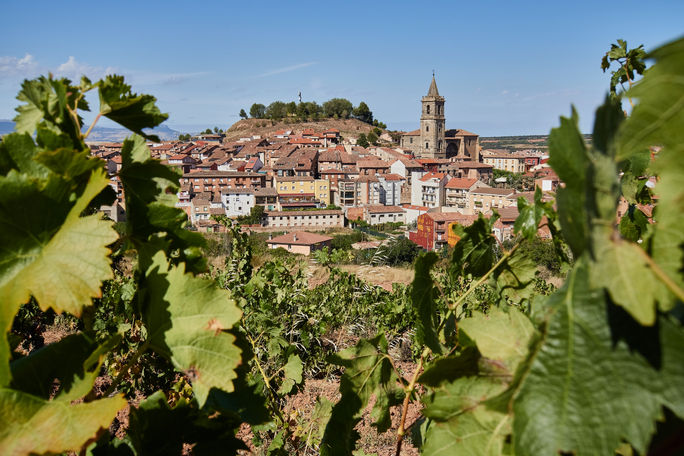
The village of Navarrete in La Rioja, Spain. (Photo Credit: Adobe Stock/Evan Frank)
Douro Valley, Portugal
The Douro Valley, located in northern Portugal, is one of the world’s oldest and most stunning wine regions, famous for its production of both Port wine and high-quality table wines. The region’s dramatic landscape, characterized by steep, terraced vineyards carved into the hillsides along the Douro River, creates a unique microclimate that is ideal for grape growing. Indigenous grape varieties, such as Touriga Nacional, Touriga Franca, and Tinta Roriz thrive in the region’s hot summers and mineral-rich soils, contributing to the bold reds and aromatic whites that have gained international acclaim. The region's winemaking history dates back over 2,000 years, with the Douro Valley earning UNESCO World Heritage status in recognition of its cultural and historical significance.
Wine tourism in the Douro Valley offers an immersive experience that combines exceptional wines with breathtaking scenery and rich traditions. Visitors can tour centuries-old quintas (wine estates) to learn about the winemaking process, from grape cultivation to barrel aging. Many estates offer guided tastings of both Port and dry wines, often paired with regional delicacies. The area’s many wine routes allow visitors to explore charming villages like Pinhão and Peso da Régua. The region also hosts annual wine festivals, such as the Douro Wine Harvest Festival, where guests can participate in traditional grape stomping and celebrate the harvest with local winemakers.
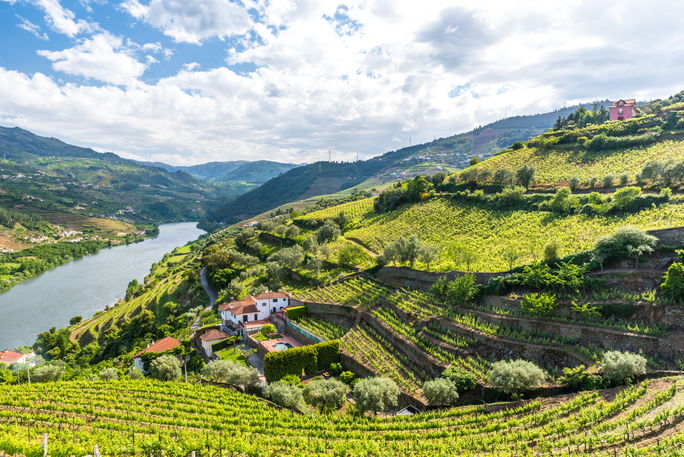
Douro Valley, Portugal. (Photo Credit: Adobe Stock/Simon Dannhauer)
Mendoza, Argentina
Mendoza, Argentina’s premier wine region, is renowned for producing world-class wines, particularly Malbec, which has become the country's signature varietal. Nestled at the foothills of the Andes Mountains, Mendoza’s high-altitude vineyards benefit from intense sunlight, cool nights and well-draining soils, creating optimal conditions for grape growing. While Malbec is the star, the region also produces exceptional Cabernet Sauvignon, Bonarda and Torrontés. Mendoza's winemaking tradition dates back to the 16th century, but in recent decades, it has gained global recognition for its high-quality wines, innovative techniques and commitment to sustainability.
Wine tourism in Mendoza offers an unforgettable experience that blends spectacular landscapes with top-tier hospitality. Visitors can explore historic and modern wineries, ranging from boutique family-run estates to large internationally renowned producers. Many wineries offer guided tastings, food pairings, and even vineyard horseback rides or hot air balloon tours with breathtaking views of the Andes. The region’s lively wine festivals, such as the annual Vendimia (Harvest Festival), celebrate Mendoza’s rich viticultural heritage with parades, music and wine-themed events.
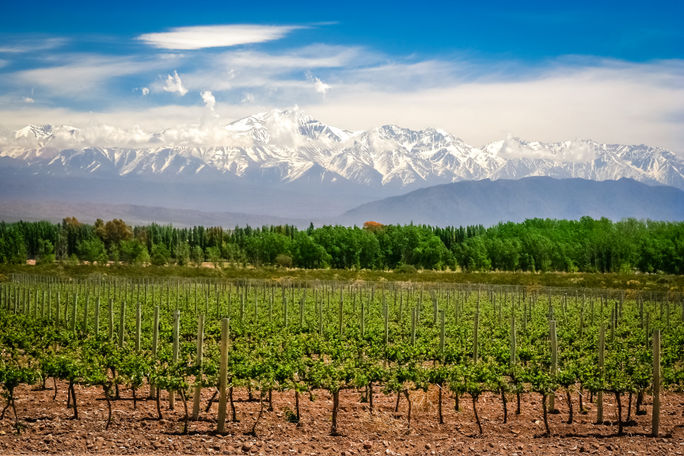
Vineyards in Mendoza, Argentina set against a snowy mountain backdrop. (Photo Credit: Adobe Stock/Pav-Pro Photography)
Casablanca Valley, Chile
Casablanca Valley, located between the Andes Mountains and the Pacific Ocean in central Chile, is a cool-climate wine region that has earned a reputation for producing some of the country’s finest white wines, particularly Sauvignon Blanc and Chardonnay, as well as high-quality Pinot Noir. The valley’s proximity to the ocean creates a long growing season with cool mornings and significant temperature variation during the day, allowing the grapes to develop balanced acidity and intense aromatics. Casablanca Valley’s winemaking history is relatively recent, with commercial viticulture beginning in the 1980s, but it has quickly gained recognition for its innovation and exceptional wines.
Wine tourism in Casablanca Valley offers a delightful and scenic experience, with many vineyards located in picturesque settings surrounded by rolling hills and views of the nearby mountains and ocean. Visitors can tour a variety of wineries, ranging from boutique operations to large well-known estates, and enjoy tastings of the region’s signature varietals, often paired with local Chilean cuisine. Many wineries also offer unique experiences, such as wine and cheese pairings, vineyard tours by bike or horseback, and cooking classes. The valley’s wine festivals and events, like the annual Casablanca Valley Wine Harvest Festival, provide an immersive way to experience the region’s rich viticultural heritage.
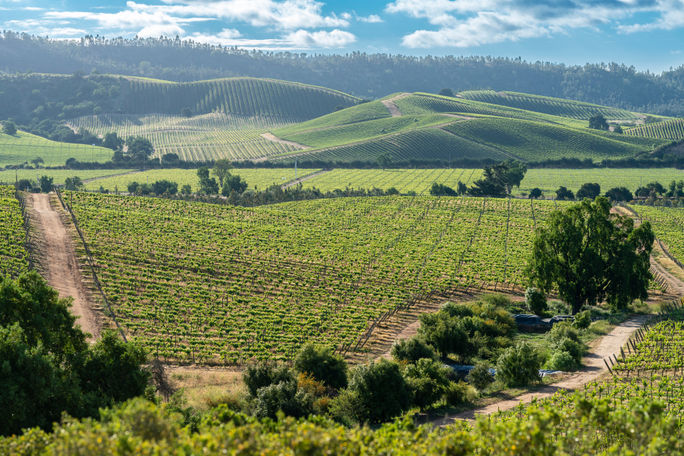
Rolling vineyards in Casablanca Valley, Chile. (Photo Credit: Adobe Stock/abriendomundo)
For the latest travel news, updates and deals, subscribe to the daily TravelPulse newsletter.
.png)
.png) 2 months ago
14
2 months ago
14








 English (US) ·
English (US) ·  Spanish (ES) ·
Spanish (ES) ·